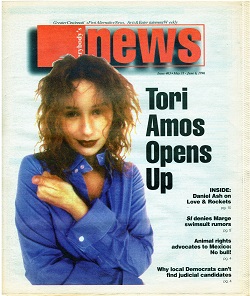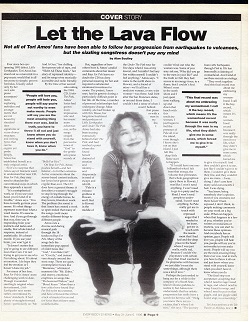|

songs | interviews | photos | tours | boots | press releases | timeline
Everybody's News (US)
An Alternative Weekly Publication In Cincinnati, Ohio
May 31-June 6, 1996

Tori Amos Opens Up
Let the Lava Flow
Not all of Tori Amos' fans have been able to follow her progression from earthquakes to
volcanoes, but the sizzling songstress doesn't pay any mind.
by Alan Sculley
Ever since her eye-opening 1991 debut, "Little Earthquakes," Tori Amos has stood out
as a maverick in a pop music world that is all too prone to simple, proven
formulas. Usually aided only by her solo piano accompaniment, exploring
melodies and arrangements that are not bound by standard time signatures or
verse-chorus structure, and writing lyrics that can be cryptic yet probe
deeply, Amos has established herself as a truly original artist.
So it's no surprise that Amos says if listeners want to understand her new CD, "Boys
for Pele," they may need to abandon the conventional ways in which they
approach a record.
"It's a metaphorical work, so if you use your head, you're kind
of in trouble," Amos says. "You have to really go from your senses. It's
what things represent more than what a word means. It's association. And if you
go through that way, then you're responding from your instincts and tastes and
smells, that whole kind of response, instead of analytically. It's a heart
record. If you use your brain, you won't get it.
"It doesn't matter that you're going to see different faces than
I am. I'm not trying to get you to see who I'm talking about. It's about an
emotion. I do hope they feel the emotion or I haven't done my job."
For many of her fans, "Boys for Pele" is Amos' most challenging work to date. Although
it sounded startlingly original when first released, "Little Earthquakes" now
seems rather conventional by Amos' standards. It had plenty of straight-forward
lyrics - particularly on "Me and a Gun," her chilling first-person tale of
rape, and "Silent All These Years," her story of repressed identity - and its
songs were musically accessible and radio friendly.
By the time of her second solo outing, the 1994 CD, "Under the Pink," Amos' lyrics had
grown more impressionistic and her music more adventurous, as the songs ranged
from the percussive tones of "God" to the gentle solo piano sounds of "Bells for
Her."
On "Boys for Pele," Amos pushes herself - and her listener - to further extremes. As her
comments about the sense-based content indicate, her lyrics have grown more
cryptic than ever. The CD does have a general theme: it describes a woman's
struggle to stop living through the energy of outside forces, be they lovers,
friends, or work. The problem (for some) is that Amos has created a work so
open-ended that many of the songs could mean starkly different things to
different people.
Amos cuts a diverse and daring musical path through the 18 tracks on "Boys for Pele." Many of the songs lack the immediate pop appeal of older tunes like "God," "Cornflake Girl," or "Crucify," and instead veer sharply around the sonic map. There are quiet, contemplative tunes like "Marianne," whimsical moments like "Mr. Zebra," and stormy, emotional eruptions like "Professional Widow" and "Blood Roses." More than a few critics have found "Boys for Pele" to be too extreme, and have criticized the CD for a lack of musical focus and for lyrics that at times seem unfathomable.
But, regardless of how others hear it, Amos' candid comments about her music and "Boys
for Pele" leave no doubt the CD has deep personal meaning for her and required
a substantial emotional investment to create. The project, Amos says, had its
genesis during a particularly difficult point in her life. At the time, a
number of personal relationships had undergone change. Most notably, she had
broken up with Eric Rosse, her long-time boyfriend and producer of "Little
Earthquakes" and "Under the Pink." Amos had also been touring extensively
behind "Under the Pink," and had reached a point where she found herself
drained of emotion and identity - and desperately in need of escape and
rebirth.
"Pele is a volcano goddess in Hawaii, and I fled to Hawaii in
the middle of the "Under the Pink" tour for five days when I was at my lowest,
and I couldn't feel any fire within myself. I couldn't feel anything," Amos says. "I came to the
north shore in Hawaii, and a friend of mine - we'll call her a medicine woman,
a very wise woman - was there. And I felt after the San Francisco dates, or around those dates, I couldn't feel a sense of when I wasn't behind that piano or with a man in my life. I couldn't find out who the woman was. Some of you
may ask me, 'Why did you go to the men in your life?' and the truth is I felt
they had an energy force, to a flame, that I couldn't find. When I went to the
north shore and I just spent time walking up and down that beach with this
medicine woman, I just began to feel the presence of Pele all over the island,
even though I know she's not on that island. I just felt this deep little flame
start to happen.
"If I could have one one-billionth of what I felt from that energy,
the volcano that permeates that whole geographical space there in Hawaii, I was like: I won't
need anything. I won't need to go a party and be liked. I won't need people to
understand. I won't need anything. So Pele really got me in touch with
repressed anger that I needed to loose, got me in touch with the resentment
that I had had and the deep place in the heart where I was really, really sad,
because I couldn't be playmates with certain boys that I had wanted to be
playmates with because we just didn't want the same things, although there was
a lot of love."
Perhaps she just needed to hang out for a while in the company of a South Seas island
volcano goddess to realize it, but Amos now understands that her artistic
progression has really been a search for her true self. "Well, you know there are no victims, that's where I sit now,"
she says. "The journey from "Little Earthquakes" through "Pink" to "Pele" has been really a claiming of womanhood. And I kind of see these records as a trilogy.
"They work together. And this final record was about me
embracing my womanhood. I call it the boy record, which means it's the
womanhood record because it was really through the men in my life, what they
didn't give me in some cases, which forced me to give it to myself. And they
couldn't give it to me, just like I couldn't give it to them. I couldn't give
them their fire, and they couldn't give me mine... I was dying. I don't care how
many sold-out concerts I had. I was dying.
"You know, being somebody else's opinion, most of you creatures
out there haven't been exposed, I don't think, to people making comments on
your work on a big scale. What can happen when that happens to a few of you,
whether you're writers or musicians or etcetera, you can start to become these opinions.
And everybody has an opinion, guys. People will love you, people will hate you,
people will say you're not worthy to even make music. People will say you're
the most amazing thing there ever was. And in truth, you just have to throw it
all out and just know where you stand with yourself, know when you don't have
it, know when you do.
"The final step was acceptance, accepting that when I need to
rage I need to rage, and when I need to weep I need to weep, and when I need to
put on that giggle, and just giggle until I can't stop, no censorship."
original article

[scans by Sakre Heinze]
t o r i p h o r i a
tori amos digital archive
yessaid.com
|